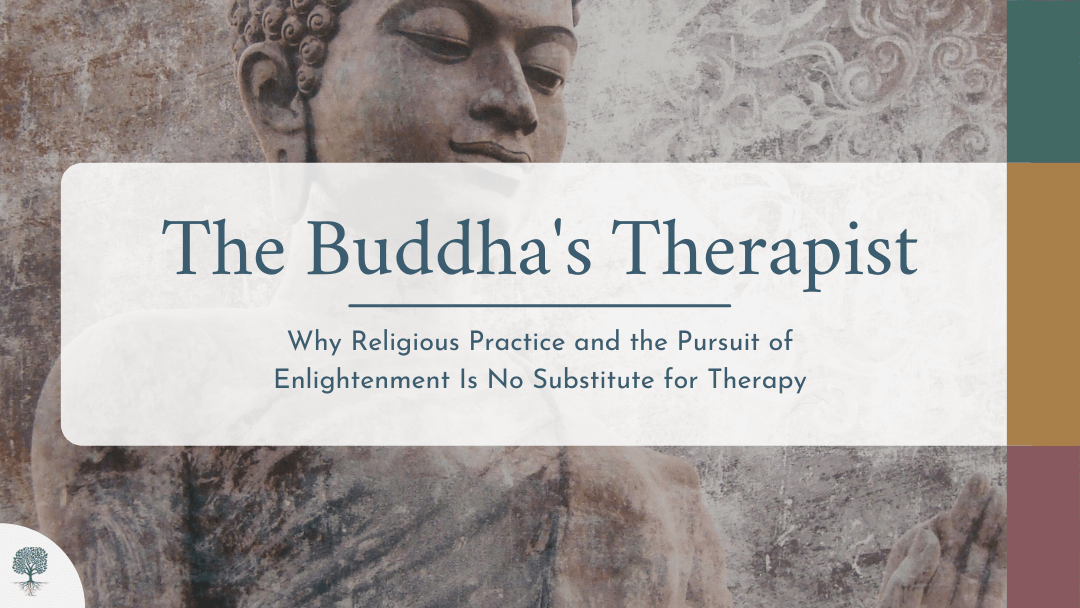“Perhaps all the dragons in our lives are princesses who are only waiting to see us act, just once, with beauty and courage. Perhaps everything that frightens us is, in its deepest essence, something helpless that wants our love.”
― Rainer Maria Rilke, Letters to a Young Poet

The Buddha’s Therapist: Reconciling Spirituality and the Shadow Self
In the realm of personal growth and self-discovery, we often encounter a puzzling paradox: individuals who appear to have reached spiritual heights yet struggle with very human flaws. This phenomenon raises important questions about the relationship between spirituality and psychology, particularly in how we address our shadow selves.
The Illusion of Enlightenment
The 1970s saw a surge of Eastern religious traditions in the United States, bringing with them promises of transcendence and enlightenment. However, as psychologists and academics observed, this spiritual awakening also revealed a darker undercurrent. Over the next three decades, numerous cases emerged of “enlightened” mystical leaders whose private lives were marred by addiction, exploitation, and even sexual abuse.
These revelations left many followers bewildered. How could individuals who spent their lives in meditation, seemingly transcending the ego, simultaneously indulge in such egocentric behaviors? While some dismissed these leaders as mere charlatans, many community members had genuinely experienced the compassionate and transformative work these figures had done. The contradiction was stark and unsettling.
The Limits of Transcendence
Eastern meditation techniques offer powerful tools for dissolving the ego and fostering a sense of universal connectedness. This state of detachment from self and connection to a greater whole is often associated with profound compassion and the stereotypical “zen” calm. As an integrative therapist with a Jungian leaning, I’ve found these mindfulness practices invaluable for self-renewal and helping patients reconnect with lost parts of themselves.
However, there’s a crucial caveat: transcendental experiences, while profound, do not inherently heal ego wounds or integrate the shadow self. Spirituality alone doesn’t help a person recognize harmful patterns, adjust limiting self-images, or develop more flexible decision-making processes. In essence, Eastern transcendentalism offers a tool for temporarily stepping outside the world to gain perspective – it doesn’t necessarily equip us to live more effectively within it once we return.
The Persistence of the Shadow
Carl Jung conceptualized the shadow as the aspects of ourselves we repress or deny. Many spiritual traditions claim that practices like mindfulness will “flood the shadow with light,” effectively eliminating it. This belief that spirituality can serve as an alternative to therapy or self-analysis often leaves religious communities more vulnerable to their collective shadows and those of their leaders.
The scandals in Buddhist communities during the ’70s and ’80s saw many individuals reliving patterns of denial, enabling, and abuse they had hoped to escape from their families. It became clear that after a mountaintop experience, one’s shadow would still be waiting at the base.
The Danger of Spiritual Bypassing
In my clinical practice, I often encounter patients who have embraced various “shortcuts” to avoid integrating their shadow selves. Some turn to substance abuse, while others lean heavily on sobriety programs, psychedelic drugs, or spiritual practices. Many explain why they’ve chosen to live with their anger or assertiveness “turned off,” effectively cutting themselves off from their inner warrior. In truth, they’re often terrified of open conflict or having to make judgments about others.
This avoidance isn’t limited to any particular spiritual or religious tradition. I’ve seen individuals cycle through being “saved,” achieving “enlightenment,” or leaving their faith altogether, each time believing this change will somehow resolve their inner conflicts. But as I once told a parishioner who claimed teenagers only needed Jesus for internet safety, “It’s been my experience that teenagers who have Jesus in their heart can still have a lot of stupid ideas in their brain.”
Integrating the Shadow: A Balanced Approach
The key to genuine growth lies not in denying or trying to eliminate the shadow, but in acknowledging and integrating it. Some religious traditions offer practices that strike this balance. For instance, the Amish tradition of Rumspringa allows young adults to experience the outside world before choosing to commit to their community. This practice acknowledges the shadow of temptation and worldly desires, allowing individuals to make a mindful choice rather than living in fear and repression.
Similarly, Zen Buddhist monks have rituals that acknowledge their capacity for gluttony and self-absorption. By symbolically “feeding” these impulses in a controlled manner, they maintain awareness of their shadow aspects without being controlled by them.
The Necessity of Shadow Work
Ultimately, enlightenment – spiritual or otherwise – is a poor substitute for genuine self-examination and integration of the shadow self. When we use faith, nationality, or any other identity to escape this crucial work, we only blind ourselves to the control our shadow exerts over our lives.
True personal growth requires a balance of spiritual insight and psychological work. By acknowledging and embracing all aspects of ourselves, including those we’d rather not see, we can achieve a more genuine and lasting transformation. The Buddha may have found enlightenment under the Bodhi tree, but even he might have benefited from a good therapist to help integrate his insights into daily life.
Bibliography
Rilke, Rainer Maria. Letters to a Young Poet. Translated by M.D. Herter Norton, W.W. Norton & Company, 1934.
Carl Jung. The Collected Works of C.G. Jung, Volume 9 (Part 2): Aion: Researches into the Phenomenology of the Self. Princeton University Press, 1959.
Carl Jung. The Collected Works of C.G. Jung, Volume 11: Psychology and Religion: West and East. Princeton University Press, 1958.
Chögyam Trungpa. Cutting Through Spiritual Materialism. Shambhala Publications, 1973.
Jack Kornfield. A Path with Heart: A Guide Through the Perils and Promises of Spiritual Life. Bantam Books, 1993.
Marianne Williamson. A Return to Love: Reflections on the Principles of “A Course in Miracles”. HarperCollins, 1992.
Philip Kapleau. The Three Pillars of Zen: Teaching, Practice, and Enlightenment. Anchor Books, 1965.
William James. The Varieties of Religious Experience: A Study in Human Nature. Longmans, Green & Co, 1902.
Ken Wilber. The Spectrum of Consciousness. Quest Books, 1977.
Mark Epstein. Thoughts Without a Thinker: Psychotherapy from a Buddhist Perspective. Basic Books, 1995.
Pema Chödrön. When Things Fall Apart: Heart Advice for Difficult Times. Shambhala Publications, 1997.
Joseph Campbell. The Hero with a Thousand Faces. Princeton University Press, 1949.
Anthony Storr. Feet of Clay: Saints, Sinners, and Madmen: A Study of Gurus. Free Press, 1996.
Eugene Taylor. Shadow Culture: Psychology and Spirituality in America. Counterpoint, 1999.
M. Scott Peck. The Road Less Traveled: A New Psychology of Love, Traditional Values and Spiritual Growth. Simon & Schuster, 1978.
Robert A. Johnson. Owning Your Own Shadow: Understanding the Dark Side of the Psyche. HarperOne, 1991.
Tara Brach. Radical Acceptance: Embracing Your Life with the Heart of a Buddha. Bantam, 2003.
Thomas Moore. Care of the Soul: A Guide for Cultivating Depth and Sacredness in Everyday Life. HarperCollins, 1992.
Thich Nhat Hanh. Peace Is Every Step: The Path of Mindfulness in Everyday Life. Bantam, 1991.



























0 Comments